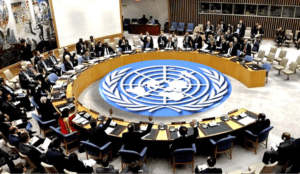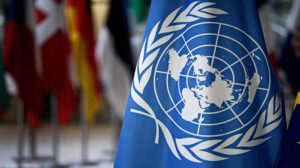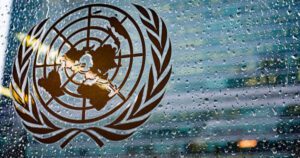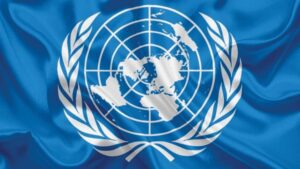
On Friday, the UN Security Council unanimously supported a peaceful settlement in Ukraine, UN Secretary General António Guterres said.
“Today, for the first time, the Security Council has unanimously spoken out for peace in Ukraine. As I have often said, the world must come together to silence the guns and uphold the values of the UN Charter,” he tweeted Friday night.

UN Secretary-General António Guterres announced the Organization’s plans to double support for Ukrainians under the conditions of war.
“I was moved by the resilience and bravery of the people of Ukraine. My message to them is simple: We will not give up. The UN will redouble its efforts to save lives and reduce human suffering. In this war, as in all wars, the civilians always pay the highest price,” Guterres said on Twitter on Friday.
As reported, the UN Secretary General arrived on a visit to Ukraine on Wednesday evening, and on Thursday morning he visited the liberated cities of Kyiv region to the north-west of the capital.

Civilian casualties from February 24, when Russia started the war against Ukraine, to 24:00 on April 27 amounted to 6,009 civilians (in the report the day before – 5,939), including 2,829 dead (2,787), reports the Office of the High Commissioner United Nations Human Rights Organization (OHCHR) on Thursday.
“OHCHR believes that the actual figures are much higher as information is delayed from some areas of heavy fighting and many reports are still awaiting confirmation,” the UN data document notes.
According to him, this applies, for example, to Mariupol (Donetsk region), Izyum (Kharkiv region) and Popasna (Luhansk region), where there are reports of numerous civilian casualties. They are subject to further verification and are not included in the above statistics.
“The majority of civilian deaths or injuries were caused by the use of explosive devices with a wide area of effect, including shelling from heavy artillery and multiple launch rocket systems, as well as rocket and air strikes,” the report says.
According to confirmed UN data, 932 men, 626 women, 75 boys and 62 girls died, while the sex of 68 children and 1066 adults has not yet been determined.
Among the 3,180 wounded were 73 boys and 66 girls, as well as 164 children whose gender has not yet been determined.
Compared to Friday’s report, according to the UN, three children were killed and another was injured.
OHCHR indicates that in Donetsk and Luhansk regions, as of midnight on April 28, there were 1,266 (1,229) dead and 1,172 (1,159) injured in government-controlled territory, and 88 (85) dead and 357 (353) injured in territory controlled by self-proclaimed “republics”.
In other regions of Ukraine under government control (in Kyiv, as well as in Zhytomyr, Zaporozhye, Kyiv, Sumy, Odessa, Mykolaiv, Kharkiv, Kherson, Dnepropetrovsk, Cherkasy and Chernihiv regions), the UN recorded 1475 (1473) dead and 1651 (1640) wounded .
The daily summary traditionally states that the increase in the figures from the previous summary should not be attributed only to the cases on April 26, since during this period the Office verified a number of cases from previous days.

UN Secretary General António Guterres has arrived in Ukraine on a visit.
“I arrived in Ukraine after visiting Moscow. We will continue our work to expand humanitarian assistance and ensure the evacuation of civilians from conflict zones. The sooner this war ends, the better for Ukraine, Russia and the world,” the Secretary General wrote on Twitter on Wednesday .

Violation of the territorial integrity of Ukraine is inconsistent with the UN Charter, said UN Secretary General Antonic Guterres.
“We firmly believe that the violation of the territorial integrity of any country is completely inconsistent with the UN Charter. We are deeply concerned about what is happening now. We believe that there has been an invasion of the territory of Ukraine,” Guterres said during negotiations with Russian President Vladimir Putin on Tuesday in Moscow.
The claims that Russia has regarding Ukrainian issues and European global security must be resolved, guided by the UN Charter, Guterres said.

The number of internally displaced persons (IDPs) in Ukraine due to the war unleashed by Russia has reached 7.7 million compared to 854 thousand before the start of the war, as of April 21 this estimate was given by the Office of the United Nations High Commissioner for Refugees (UNHCR ), which as of April 6 estimated this figure at 7.1 million.
“The Russian Federation launched a military offensive against Ukraine on February 24, 2022. To date, more than 5 million refugees have left Ukraine, making this the fastest growing refugee crisis since World War II. Another 7.7 million people have been displaced inside Ukraine,” it says in a report on his website.
UNHCR estimates that some 13 million people are stuck in affected areas or unable to leave due to heightened security risks, destruction of bridges and roads, and a lack of resources or information on where to find safety and shelter.
The organization notes that the delivery of vital aid remains challenging due to the lack of safe humanitarian access.
Citing UNICEF and WASH partners, UNHCR reports that 1.4 million people are currently without access to water in eastern Ukraine and that another 4.6 million people across Ukraine are at risk of losing such access. The organization also points to the persistence of the difficult situation in Kherson.
“UNHCR continues to call for the protection of civilians and civilian infrastructure, respect for international humanitarian law, and neighboring countries to continue to keep their borders open to refugees,” the report emphasizes.
As Prime Minister Denys Shmygal said on April 13, 1 million people have already registered as new IDPs as a result of the Russian invasion. The state announced that it would make monthly payments for registered IDPs in the amount of UAH 2,000 per adult and UAH 3,000 per child.
According to UNHCR data, as of 13:00 on April 22, a total of 5.16 million people left Ukraine since the beginning of the war (excluding the flow to enter), of which 2.88 million went to Poland, 838.86 thousand to Romania and Moldova. , Russia – 578.26 thousand, Hungary – 485.62 thousand, Slovakia – 352.29 thousand, Belarus – 23.9 thousand.
The UNHCR, referring to data from the State Border Service of April 22, also indicated that since February 28, the flow to enter Ukraine amounted to 1.12 million people, thus the total number of refugees is about 4 million.